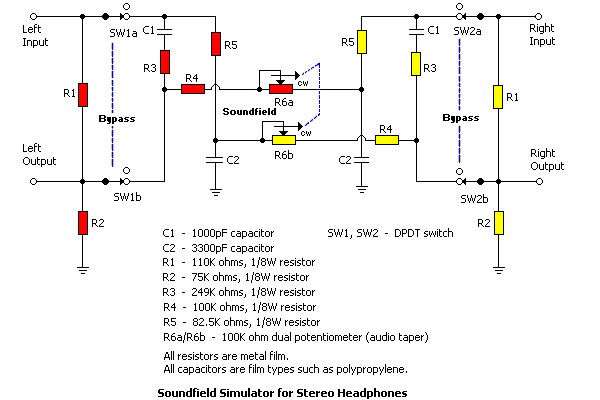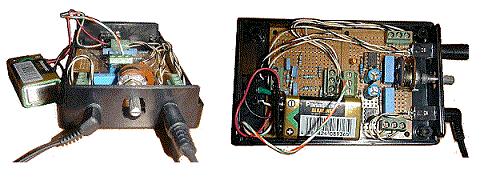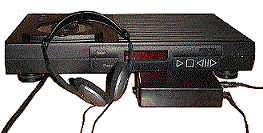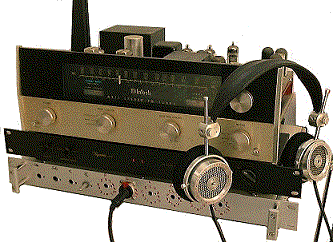
A Soundfield Simulator for Stereo Headphones
by Chester Simpson
I built up a version of the "crossfeed acoustic simulator" circuit described in An Acoustic Simulator for Headphone Amplifiers by Chu Moy and optimized it to go in front of (at the input side) of my headphone amplifier design (see A DC-Coupled, Selectable-Gain Headphone Amplifier). Since my amp's input impedance is 1 Megohm, I used larger value resistors that can be driven easily from any line output. I like the result so much that I have prepared this article as a followup to my headphone amp project.

Figure 1
Figure 1 shows the schematic of the modified crossfeed circuit. The "low impedance" version of this circuit described in the article by Chu Moy can be connected directly to the headphones, so that the headphone impedance interacts with the output impedance of the simulator. I optimized mine to go at the input of my headphone amplifier, a luxury I had because my headphone amp has such a high input impedance. This circuit presents an input impedance of about 150K ohms to the source driving it, which means it is well-matched to the output of any "line" source - like the output of a CD player or tape deck. The output impedance of this circuit is about 50K ohms, so if the input impedance of the headphone amp is lower than about 250K ohms, a buffer should be used to prevent loading (not a problem if you use my headphone amp).
This circuit has a very subtle effect on the perceived soundfield. It typically makes the sound appear to come from a point slightly ahead of your ears (as opposed to exactly in your ears) and improves the "spacious" of headphones and reduces listening fatigue. The component values are the result of a lot of tweaking so that the tonal quality would not affected as the pot is adjusted from min to max. The dual audio taper pot is sold at Radio Shack (RS 271-1732)
The changes in the soundfield are dependent on the type of music and (of course) frequency content. It has the greatest effect when a single source is placed in only one channel. With some music, switching in and out appears to have no effect. With other songs, it is very easy to tell the difference. A friend of mine did a "blind A-B" switch test while I listened to see if I could pick up the difference, and I missed more times than I hit. But then, I listen to rock music. Interestingly, there are some songs I found where the effect was very pronounced ("Starider" by Foreigner was one).
As you crank the pot for minimum resistance (full CW rotation), you get maximum crossfeed. It sounds as if the sound is moving from at your ears to a little in front of your ears. If a vocal was fully in the left ear, it would sound as if the person moved more toward center and more out front of you. The crossfeed makes it so there are no "isolated" sound sources sitting either directly to the left or right. Another way to look at it might be that you are stepping back a bit and making the sound sources be more in front of you.
Overall, I never switch to "BYPASS" or adjust the pot to any setting below full CW rotation (zero resistance). Therefore, I would say both the BYPASS switch and the POT are not really necessary and could be left out. But, the BYPASS switch is fun to play with to do A-B testing to see how much change you can pick up switching it in and out.
I can confirm that I get less listening fatigue using the circuit. I think I know the reason why, based on recent research done into the causes of tinnitus (a ringing sound usually heard in one ear more than the other). PET scans of the brain show that even when a sound is fed into only one ear, there is brain activity on both sides (i.e., in both "hearing" centers). It is becoming clear that the ears are "cross-wired" in a complex way that is not fully understood.
What is absolutely known is that the brain cannot tolerate assymetry: it cannot process two images when one is out of whack. Ears listening to loudspeakers always hear in both ears, even if a particular sound is 100% in one channel. The "off-side" ear hears the sound (mostly via reflection), so it is lower in volume and arrives a bit later. It is the differential volume and time phase shift that allows the brain to perceive the direction of the source of the sound.
Headphones violate the brain's normal processing method because some of the sounds originate in only one channel and the other ear does not pick up the reduced-volume/time-delayed signal that should accompany the source signal. Fortunately, most music is not channeled with such absolute separation, so the effect is not overwhelming, just annoying. Using crossfeed improves this, although I think that acoustic simulators with more accurate time-delay capability would probably be better (assuming they were done correctly).
Chester Simpson is an engineer in the Power Supply Division at National Semiconductor.
ADDENDUM
10/30/99: Corrected figure 1 - removed connection between left channel R3 and right channel R3.
1/12/00: scrazy@gcn.net.tw built this version of the pocket amp, which has a 10K ohm volume control and an acoustic simulator front-end that is based on the circuit by Chester Simpson (see design by Fred Peng below). Full details can be found at DIY Zone (in chinese only). His system consists of a Rega Planet CD Player and Audio Technica ATH-f15 headphones.


1/13/00: Fred Peng based his headphone amplifier on the acoustic simulator by Chester Simpson, except that he replaced the R4,R6 combination in Simpson's circuit with a 100K ohm resistor and added a unity gain input buffer stage made from an OPA134 and a high current output stage made from a PMI BUF-03 buffer. When compared with a McCormack Micro Headphone Drive, the BUF-03 driving his Grado HP-1 headphones with the simulator bypassed sounded better in the high and low frequencies than the McCormack, but the McCormack was better in the mid frequencies. With the simulator switched in, the sound was more relaxed, the low frequencies more centered, and the soundfield moved from inside his head to outside. He is very satisfied with the result and is planning to make another simulator for his Stax Lambda headphones. Full details and schematics (in chinese only) can be found at DIY Zone.

c. 1999, Chester Simpson.